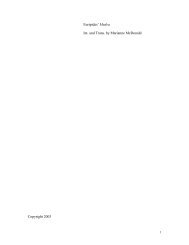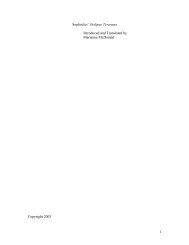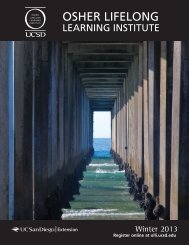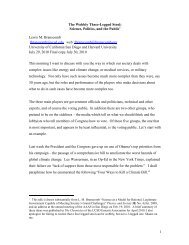1 Sophocles' Antigone Introduction, translation, and notes by ...
1 Sophocles' Antigone Introduction, translation, and notes by ...
1 Sophocles' Antigone Introduction, translation, and notes by ...
Create successful ePaper yourself
Turn your PDF publications into a flip-book with our unique Google optimized e-Paper software.
Just before the entrance of Teiresias, the ensemble make wind sounds. The chorus<br />
look nervous seeing this holy man approach.<br />
At the end the dead bodies are symbolically represented <strong>by</strong> an article of clothing.<br />
Haemon throws his cloak at his father. Eurydice lays her cape down at Creon’s feet.<br />
Finally, <strong>Antigone</strong> puts her wreath next to the two “bodies.” The four actors that began<br />
reciting the names at the beginning start again. They fade away <strong>and</strong> Ismene says quietly,<br />
“<strong>Antigone</strong>?” three times. The lights go up.<br />
SUGGESTED PROGRAM NOTES<br />
Ancient Athens in the fifth century before Christ produced the first written dramas in the<br />
western world. Sophocles was one of the three great playwrights who lived then <strong>and</strong><br />
whose work we have. He wrote the Oedipus Rex, which twenty-five centuries later led<br />
Freud to his theory of the Oedipus complex. Sophocles wrote about 123 plays, of which<br />
only seven survive to this day all of which are recognized as masterpieces. Sophocles’<br />
heroes struggle to right the wrongs they perceive in the world about them.<br />
<strong>Antigone</strong> is the first, <strong>and</strong> remains, the greatest play in western literature about the<br />
consequences of individual conscience defying civil authority. <strong>Antigone</strong> is the favorite of<br />
many. In her clash with King Creon, as she defends the rights of the family, <strong>Antigone</strong><br />
invokes “the unwritten law of the gods,” whereas Creon rests his case on defending the<br />
safety <strong>and</strong> security of the state against anarchy.<br />
These issues about human rights have everlasting relevance. This play is performed<br />
whenever a country is in trouble: it is sometimes the only way people can fight back<br />
against abusive authority. This play resonates with timeless immediacy in situations of<br />
conflict. Plays have often been used in repressive conditions to reveal the truth when the<br />
mass media like newspapers, radio or television have been silenced <strong>by</strong> censorship.<br />
Anouilh wrote an <strong>Antigone</strong> for fascist Paris in 1944; in 1948 Brecht used <strong>Antigone</strong> as a<br />
model for his Mother Courage, an archetype of the rebellious woman suitable for any age;<br />
Athol Fugard’s The Isl<strong>and</strong>, performed in 1973, shows black prisoners incarcerated on<br />
Robben Isl<strong>and</strong> in South Africa performing this play to keep their sanity in the midst of the<br />
insanity of Apartheid, an unjust system of government which deprived an entire segment<br />
of the population of their human rights. In 1984, Tom Paulin shows us an <strong>Antigone</strong> (The<br />
Riot Act) from the North of Irel<strong>and</strong>, <strong>and</strong> she is a freedom fighter, whereas Creon’s words<br />
sound like Ian Paisley’s. In 1986, Brendan Kennelly also sees the Irish relevance in his<br />
<strong>Antigone</strong>, with a deadly net of words strangling substantive action.<br />
But most of all, this play is a human drama <strong>and</strong> a tragedy that shows two passionate<br />
people who go hell-bent to destroy themselves <strong>and</strong> others. The price of supporting their<br />
30









